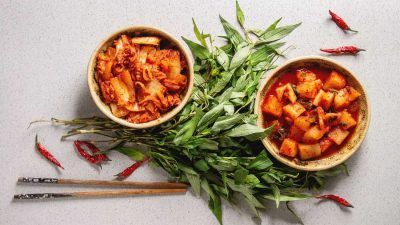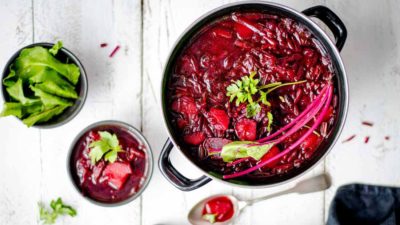Sauerkraut

Fermenting v pickling
These methods were developed as a means of preserving vegetables for winter months when fresh produce was scarce. While both result in a characteristically tangy and savoury taste, they are very different processes.
Pickling involves preserving vegetables in an acidic brine, using vinegar as the main ingredient. It is quick, cheap and fuss-free and you can pickle almost any vegetable. Once the pickle is done, it can be stored at room temperature.
Fermenting, on the other hand, is a natural preservation process in which bacteria use the carbohydrates in vegetables to produce lactic acid. The acid is responsible for the sour taste and preserves the veggies. The final product usually has to be kept in a cool place to prolong its shelf-life. It’s a lengthier method but the result is healthier than pickling.
No special bacteria are needed for fermenting as the process uses bacteria naturally present on the vegetables. When you cover vegetables with water you cut off their oxygen supply and that’s when the bacteria start converting carbohydrates into acid, suppressing the growth of other microbes that could otherwise cause spoilage. These bacteria also produce vitamin K and some B vitamins, increasing the nutritional value of the food.
When you eat fermented foods you also eat the lactic acid bacteria, which join with those bacteria that already live in your colon and help you to digest food – far better than taking probiotics! Fermented foods help to lower inflammation in the gut by restoring balance. And there’s another benefit – because fermented veggies are essentially pre-digested by the bacteria, it is easier for your body to absorb their nutrients.
Sauerkraut
Sauerkraut is shredded and salted raw cabbage fermented with various lactic acid bacteria. The name comes from German where sauerkraut (sour cabbage) is a national dish but it is not a German invention. The practice of fermenting cabbage was likely brought to Europe from China and it then became popular in Eastern, Central and Western European countries.
Sauerkraut is a great source of vitamin C, vitamin K and iron because fermenting makes these more bioavailable. It also contains some calcium, manganese, B vitamins and is an excellent source of fibre. To get the most benefits from sauerkraut, eat it raw because cooking not only destroys vitamin C, it also kills the good bacteria in it.
If you’ve just finished a course of antibiotics, sauerkraut may be your new best friend as antibiotics tend to kill all bacteria – the bad ones causing disease but also the good ones in your gut. By eating sauerkraut, you’re repopulating your gut with the good bacteria (probiotics) and at the same time providing them with the food they need (prebiotics) – fibre and complex carbohydrates.
The only downside of sauerkraut is that it contains a fair amount of salt so it’s best not to eat a pound in one sitting!
More health benefits!
Cabbage – and therefore sauerkraut too – has anti-cancer properties, is anti-inflammatory and antioxidant and so helps to protect your overall health.
Sauerkraut (and kimchi as well) can be effective at helping to combat the Helicobacter pylori infection in the stomach – a bacterial infection that increases your risk of stomach ulcers and cancer and tends to be very stubborn. Bacteria from fermented foods help to control these nasty bacteria and support any medical treatments.
If you have high blood pressure bear in mind that sauerkraut is relatively high in salt but if you’re healthy and into sports, this may be an advantage – sauerkraut juice is a great electrolyte drink with a dose of health-boosting bacteria!






